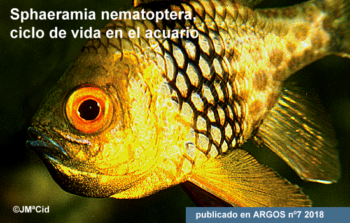Scartella cristata, una especie realmente cosmopolita
Autor: Jose Maria Cid RuizResumen
Scartella cristata. Este artículo describe una experiencia práctica en su mantenimiento y reproducción. Su autor, José María Cid Ruiz, nos describe las diferentes técnicas y protocolos, desarrollados durante el proyecto, para el mantenimiento y reproducción de la especie. Los blenios, son en general especies sedentarias, de hábitos y existencia básicamente bentónicos. En buena parte debido, a que un gran número de especies comprendidas en la familia Blennidae, han evolucionado anatómicamente, hacia una atrofia cuando no carencia total de vejiga natatoria. Pero lo cierto es, que nada de lo dicho anteriormente, le ha impedido a esta especie (“blenio peineta”, “molly miller blenny”), distribuirse ampliamente por medio planeta.
Centrándonos en sus condiciones óptimas de mantenimiento en cautividad, es tal la cantidad de biotopos que habita en la naturaleza, que el espectro de acuarios donde puede mantenerse con calidad de vida alta es muy amplio: desde un acuario templado mediterráneo, con temperaturas en invierno de 18-20ºC, salinidades de S:38 g/l y moderadas concentraciones de Ca++ y Mg++ hasta acuarios de arrecife a 27-28ºC, salinidades de S: 33-34 g/l y muy altas concentraciones de Ca++ (400 mg/l) y Mg++ (1350 mg/l). Un mantenimiento orientado a la reproducción de esta especie, nos conduce a la utilización de un acuario específico de unos 200 l donde albergar un harem formado por un macho y 4-5 hembras. Idealmente, no debe ser un acuario muy alto, pero sí dotado de una gran superficie donde replicar un “litoral rocoso”.
El desarrollo completo del embrión dentro del huevo se lleva a efecto entre 11 y 12 días en un rango de temperatura del agua de 18º a 21º C y entre 8 y 9 días si la temperatura oscila entre los 22º y los 25º C. Las larvas miden 3 mm al nacer y son pelágicas (en la naturaleza forman parte del ictioplancton y es la fase, en que esta especie sedentaria puede desplazarse para ocupar nuevas áreas). Las larvas nacen con la boca ya abierta y un reducido saco vitelino que reabsorben en las primeras 8 horas, durante las cuales se mantienen cerca de la superficie o en aguas medias con una natación a “tirones”.
Abstract
Scartella cristata. This article describes a practical experience in its maintenance and reproduction. Its author, José María Cid Ruiz, describes the different techniques and protocols, developed during the project, for the maintenance and reproduction of this species. Blennies are generally sedentary species, with basically benthic habits and existence. Largely due to the fact that a large number of species included in the Blennidae family have evolved anatomically, towards atrophy when there is no complete lack of a swim bladder. But the truth is that nothing of the aforementioned has prevented this species («blenny comb», «molly miller blenny»), to distribute itself widely across half the planet.
Focusing on its optimal conditions of maintenance in captivity, the amount of biotopes that inhabits in nature is such that the spectrum of aquariums where it can be maintained with high quality of life is very wide: from a temperate Mediterranean aquarium, with winter temperatures of 18-20ºC, S salinities: 38 g / l and moderate concentrations of Ca ++ and Mg ++ to reef aquariums at 27-28ºC, salinities S : 33-34 g / l and very high concentrations of Ca ++ (400 mg / l) and Mg ++ (1350 mg / l). A maintenance oriented to the reproduction of this species, leads us to the use of a specific aquarium of about 200 l where to house a harem formed by one male and 4-5 females. Ideally, it should not be a very tall aquarium, but it does have a large surface where you can replicate a “rocky coastline”.
The complete development of the embryo within the egg takes place between 11 and 12 days in a water temperature range of 18º to 21º C and between 8 and 9 days if the temperature ranges between 22º and 25º C. The larvae measure 3 mm at birth and are pelagic (in nature they are part of the ichthyoplankton and it is the phase in which this sedentary species can move to occupy new areas). The larvae hatch with their mouths open and a small yolk sac that they reabsorb in the first 8 hours, during which they are kept close to the surface or in medium waters with a «tugging» swim.




